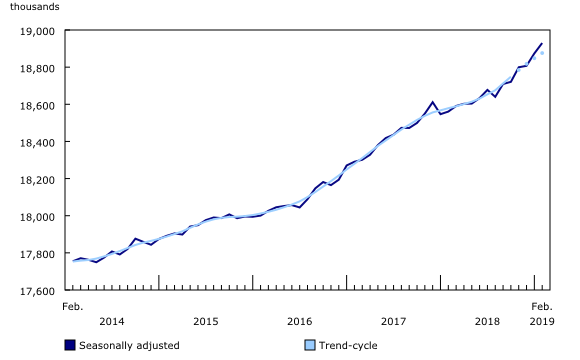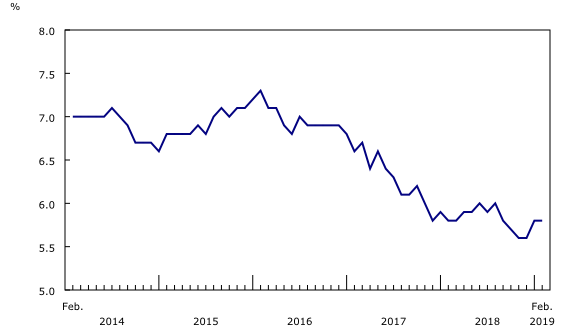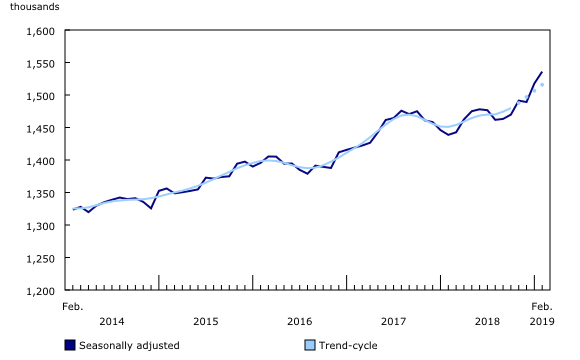Labour Force Survey, February 2019
Archived Content
Information identified as archived is provided for reference, research or recordkeeping purposes. It is not subject to the Government of Canada Web Standards and has not been altered or updated since it was archived. Please "contact us" to request a format other than those available.
Released: 2019-03-08
Employment grew for a second consecutive month, up 56,000 in February, driven by gains in full-time work. The unemployment rate was unchanged at 5.8% as the number of people searching for work held steady.
In the 12 months to February, total employment grew by 369,000 or 2.0%, reflecting increases in both full- (+266,000) and part-time (+103,000) work. Over the same period, total hours worked were virtually unchanged.
To explore the most recent results from the Labour Force Survey in an interactive format, visit the "Labour Force Survey in brief: Interactive app."
Highlights
Ontario was the sole province with a notable employment gain in February. Employment declined in Manitoba, and was little changed in the remaining provinces.
More people were employed in professional, scientific and technical services; public administration; natural resources; and agriculture. At the same time, there were fewer workers in accommodation and food services, as well as transportation and warehousing.
The overall number of employees increased, while self-employment was little changed.
Employment rose for both women and men aged 15 to 24, while it was little changed for the other demographic groups.
Notable employment increase in Ontario
Employment in Ontario rose for the second consecutive month, up 37,000 in February, boosted by gains in full-time work (+59,000). The unemployment rate was unchanged at 5.7% as more people participated in the labour market. On a year-over-year basis, employment in the province increased by 2.7% or 192,000.
In Manitoba, employment declined by 3,300 in February. The unemployment rate was little changed at 5.3% as fewer people were participating in the labour market. Compared with 12 months earlier, employment in the province rose by 1.9% or 12,000.
Employment edged up in Quebec in February, continuing the upward trend that began in the autumn of 2018. The unemployment rate was little changed at 5.3%. In the 12 months to February, employment in the province increased by 1.3% or 55,000.
In Alberta, employment was virtually unchanged from the previous month and on a year-over-year basis. The number of people searching for work increased in February, pushing the unemployment rate up 0.5 percentage points to 7.3%.
Professional, scientific and technical services leads employment growth
The number of workers in professional, scientific and technical services increased notably for the third time in four months, up 18,000 in February. Most of the gains were in Ontario and Quebec. Compared with February 2018, national employment in this industry rose by 6.8% (+97,000). On a trend-cycle basis, employment in this industry has been up since March 2018, growing at faster pace since the autumn.
Employment in public administration rose for the second consecutive month, up 14,000 in February. Most of this monthly increase was in Ontario and Alberta. Compared with 12 months earlier, national employment in this industry increased by 3.6% (+34,000).
In natural resources, employment grew by 8,000 in February and was little changed on a year-over-year basis.
In February, 6,000 more people were working in agriculture, with the gains concentrated in Quebec. In the 12 months to February, employment in this industry was little changed at the national level.
In contrast, the number of people employed in accommodation and food services declined for the second consecutive month, down 14,000 in February. Employment in this industry was little changed on a year-over-year basis.
Employment was down by 11,000 in transportation and warehousing, the first notable decline since January 2016. Most of the decrease was in Ontario. On a year-over-year basis, national employment in this industry grew by 5.5% (+54,000).
In both the public and private sectors, there was little change in the number of employees in February. When combined, the total number of employees in the two sectors increased by 41,000. On a year-over-year basis, the number of private-sector employees rose by 319,000 (+2.7%), while public-sector employment was little changed.
There was also little change in the number of self-employed workers on both a monthly and year-over-year basis.
Demographic overview
The number of employed youth aged 15 to 24 increased for the second consecutive month, up 29,000 in February. The increase was split between young women (+16,000) and young men (+13,000). The unemployment rate for youth was little changed, at 10.8%, as more of them participated in the labour market. In the 12 months to February, youth employment increased by 1.5% or 37,000.
For people in the core working ages of 25 to 54, employment was little changed and the unemployment rate was 4.8%. Compared with 12 months earlier, employment for this age group increased by 1.8% or 221,000, mostly among women (+2.9% or +167,000).
In February, employment was also little changed among people aged 55 and older. Their unemployment rate increased 0.4 percentage points to 5.5% as more of them searched for work. On a year-over-year basis, employment for this age group grew by 2.8% or 111,000.
Spotlight: Participation rate of women in Canada
The participation rate is a measure of the share of Canada's population aged 15 and older who are working or looking for work. This indicator can be calculated for subpopulations based on characteristics such as age, sex, province, immigrant status and Aboriginal status.
In 1950, less than one-quarter (21.6%) of women aged 25 to 54 participated in the labour market. By 1991, that proportion had risen to just over three-quarters (75.9%). The increase in women's participation coincided with socio-demographic and economic changes, such as increased participation in higher levels of education, delayed marriage and childbearing, and increased separation and divorce.
In recent years, after the 2008/2009 recession, the participation rate for core-aged women continued to rise, but at a slower pace, reaching 83.2% in 2018 (+1.3 percentage points). Provincially, core-aged women in Newfoundland and Labrador recorded the fastest growth in their participation rate over the 10-year period, up 5.0 percentage points to 81.6% in 2018, followed by those living in Quebec (+3.9 percentage points to 86.7%).
Over the same period, the participation rate for Aboriginal core-aged women rose 2.5 percentage points to 73.8%, while for immigrant women in the same age group, the rate increased 2.3 percentage points to 77.7%.
According to 2017 data from the Organisation for Economic Co-operation and Development (OECD), Canada's participation rate for women aged 25 to 54 (82.9%) was higher than the OECD average of 73.0%. Compared with Canada, the participation rate of core-aged women was higher in Sweden and Iceland (88.7%) and lower in the United States (75.0%).
For more labour-related information on the aging population, immigrant population, and Aboriginal population, please consult: "The impact of aging on labour market participation rates," "The Canadian Immigrant Labour Market: Recent Trends from 2006 to 2017" and "Aboriginal People Living Off-Reserve and the Labour Market: Estimates from the Labour Force Survey, 2007 to 2015."
For additional information related to women in the labour market, please consult: "Who are the Working Women in Canada's Top 1%," "Infographic: Working women in Canada's top 1%: Who are they?" and "Earnings Inequality and the Gender Pay Gap in Canada: The Role of Women's Under-representation Among Top Earners."
Sustainable Development Goals
On January 1, 2016, the world officially began implementation of the 2030 Agenda for Sustainable Development—the United Nation's transformative plan of action that addresses urgent global challenges over the next 15 years. The plan is based on 17 specific sustainable development goals.
The Labour Force Survey is an example of how Statistics Canada supports the reporting on the Global Goals for Sustainable Development. This release will be used in helping to measure the following goals:


Note to readers
The Labour Force Survey (LFS) estimates for February are for the week of February 10 to 16.
The LFS estimates are based on a sample and are therefore subject to sampling variability. As a result, monthly estimates will show more variability than trends observed over longer time periods. For more information, see "Interpreting Monthly Changes in Employment from the Labour Force Survey."
Estimates for smaller geographic areas or industries also have more variability. For an explanation of the sampling variability of estimates and how to use standard errors to assess this variability, consult the "Data quality" section of the publication Labour Force Information (71-001-X).
This analysis focuses on differences between estimates that are statistically significant at the 68% confidence level.
The LFS estimates are the first in a series of labour market indicators released by Statistics Canada, which includes indicators from programs such as the Survey of Employment, Payrolls and Hours (SEPH), Employment Insurance Statistics, and the Job Vacancy and Wage Survey. For more information on the conceptual differences between employment measures from the LFS and SEPH, refer to section 8 of the Guide to the Labour Force Survey (71-543-G).
The employment rate is the number of employed people as a percentage of the population aged 15 and older. The rate for a particular group (for example, youths aged 15 to 24) is the number employed in that group as a percentage of the population for that group.
The unemployment rate is the number of unemployed people as a percentage of the labour force (employed and unemployed).
The participation rate is the number of employed and unemployed people as a percentage of the population.
Full-time employment consists of persons who usually work 30 hours or more per week at their main or only job.
Part-time employment consists of persons who usually work less than 30 hours per week at their main or only job.
Total hours worked refers to the number of hours actually worked at the main job by the respondent during the reference week, including paid and unpaid hours. These hours reflect temporary decreases or increases in work hours (for example, hours lost due to illness, vacation, holidays, or weather; or more hours worked due to overtime).
In general, month-to-month or year-to-year changes in the number of people employed in an age group reflect the net effect of two factors: (1) the number of people who changed employment status between reference periods; and (2) the number of employed people who entered or left the age group (including through aging, death or migration) between reference periods.
Seasonal adjustment
Unless otherwise stated, this release presents seasonally adjusted estimates, which facilitate comparisons by removing the effects of seasonal variations. For more information on seasonal adjustment, see Seasonally adjusted data – Frequently asked questions.
Chart 1 shows trend-cycle data on employment. These data represent a smoothed version of the seasonally adjusted time series, which provides information on longer-term movements, including changes in direction underlying the series. These data are available for the national and provincial employment series in table 14-10-0287-01 and for national employment by industry in table 14-10-0355-01. For more information, see the StatCan Blog and Trend-cycle estimates – Frequently asked questions.
Next release
The next release of the LFS will be on April 5.
In the coming months, the LFS Daily will be enhanced to make greater use of data visualisation.
Products
Labour Force Information (71-001-X), is now available for the week ending February 16.
More information about the concepts and use of the Labour Force Survey is available online in the Guide to the Labour Force Survey (71-543-G).
The product "Labour Force Survey in brief: Interactive app" (14200001) is now available. This interactive visualization application provides seasonally adjusted estimates available by province, sex, age group and industry. Historical estimates going back five years are also included for monthly employment changes and unemployment rates. The interactive application allows users to quickly and easily explore and personalize the information presented. Combine multiple provinces, sexes and age groups to create your own labour market domains of interest.
The product "Labour Market Indicators, by census metropolitan area, seasonally adjusted" (71-607-X) is also available. This interactive dashboard provides easy, customizable access to key labour market indicators. Users can now configure an interactive map and chart showing labour force characteristics at the national, provincial or census metropolitan area level.
The product "Labour Market Indicators, by province, territory and economic region, unadjusted for seasonality" (71-607-X) is also available. This dynamic web application provides access to Statistics Canada's labour market indicators for Canada, by province, territory and economic region and allows users to view a snapshot of key labour market indicators, observe geographical rankings for each indicator using an interactive map and table, and easily copy data into other programs.
Contact information
For more information, contact us (toll-free: 1-800-263-1136; 514-283-8300; STATCAN.infostats-infostats.STATCAN@canada.ca).
To enquire about the concepts, methods or data quality of this release, contact Emmanuelle Bourbeau (613-951-3007; emmanuelle.bourbeau@canada.ca) or Martha Patterson (613-299-3942; martha.patterson@canada.ca), Labour Statistics Division.
- Date modified:






